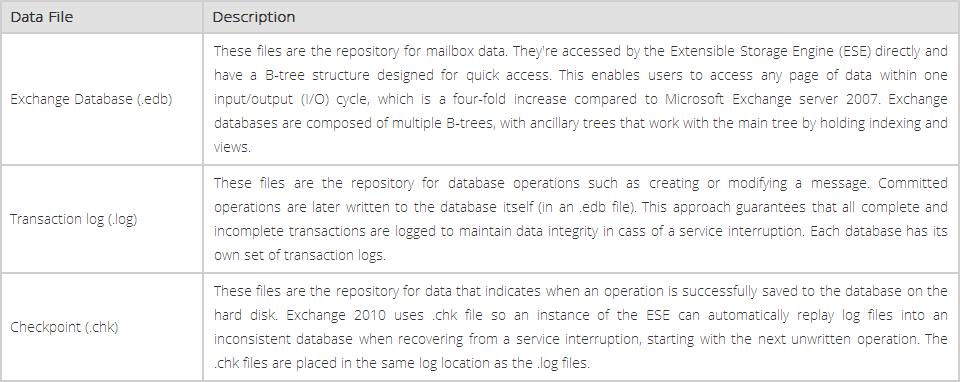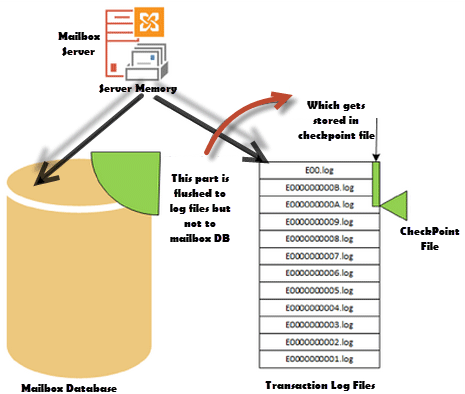The Exchange Store (store.exe) is the main repository of Exchange Server 2010 edition. In this article, the infrastructure of store.exe along with its components and other important details are covered up along with manual & automated solution to recover and export mailboxes in corruption circumstances.
There are two major components that make up database of Exchange Server:
Private Folders as the name suggests stores private information of an individual user. It comprises if data and its definitions, flags, indexes etc. For every private folder, an individual mailbox is created that get saved in priv.edb file.
Public Folders again comprises of same information as that of private folders but is shared amongst various users within Exchange environment. The accessibility of this folder depends upon permissions that can be set through Exchange Management Shell conveniently or through Exchange Management Shell.
Structure of Exchange Server 2010 Store is managed through three special kind of data files: the Exchange database files (.edb), the transaction log files (.log), and the checkpoint files (.chk). However, you won't come across these files until operations like online backup, soft/hard recovery has to be performed. The following table describes all these data files in short:

Exchange Server is popularly known as transaction based email client. A transaction is a set of operations that are performed on a database (example: deletion, insertion, or up-dation) and follows ACID properties:
A transaction is committed only when it is it passes the durability test which means the changes and the DB are protected against any kind of loss. And the database engine (ESE) will only commit a transaction when there is surety that transaction is flushed from memory to the disk (into LOG files).

Most of the Exchange DBA's would agree to the fact that for data recovery case of disaster, transaction logs are very important. Log file contains information that database (.edb) file does not and if they are missing, the entire database will be inconsistent or unusable. Extensible Store Engine (ESE) uses the concept of Write-Ahead Logging where the transactions are first written to the dis or log files before being written to the Information Store. This mechanism is to avoid hardware failures and the database will remain in consistent state even if the system crashes.
LOG files are generated in a sequential manner and store data according to order the transaction occur. Depending upon the version, each log file can contain a specific amount of data and once that much space is occupied, new log files with corresponding series get generated. LOG file for first storage group is named automatically as E00.log and when it gets filled, a new file will get created with changes in prefix like E01.log, E02.log,….E0n.log. However, it has to be noticed that the numbering is done is hexadecimal format.
What is Checkpoint File? - For database recovery, not all log files are required and Checkpoint file is the mechanism that tells from which transaction log file the recovery should start. A checkpoint (.chk) file keeps a track of transactions that are still not committed to database. Corresponding to a log file, a checkpoint file gets generated with name like E0n.CHK that is meant to maintain a status between the memory and database files on disk. This means that an indication will be received as from which uncommitted transaction the recovery process has to be started.
JET database engine has two variants: JET "Red" and JET "Blue". While the JET Red was meant for single database engine (example MS Access), the JET Blue is well suited for multi-user access and thus is used in Exchange Server. The Blue variant of JET was renamed as Exchange Extensible Engine (ESE).
This database engine technique stores Exchange Server database in a B-tree. Every table in Information Store is a collection of B-Trees. The index of a balanced-tree helps to reduce I/O operations required to access the database.
Exchange Server 2010 is integrated with facility to detect and fix store database if it is found unhealthy. Using Exchange Troubleshooters or Isinteg utility, Information Store health can be checked out. Poison (corrupt) mailboxes can be detected and repaired using the PowerShell cmdlets. To repair a corrupt mailbox, the New-MailboxRepairRequest command can be used. The quality of these cmdlets is you can use them while the database is running live.
To detect corruption in mailbox, following cmdlet can be used:

Apart from PowerShell command to repair unhealthy data, there's a reliable & effective Tool available which instantly performs recovery & EDB to PST Exchange 2010 conversion. The solution has power to work around consequences of physical and logical EDB file corruption.